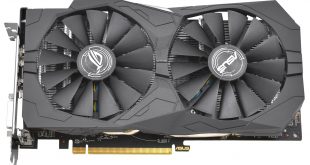Asus Rog Strix Radeon Rx 570 4gb Review
ASUS RX 570 STRIX Gaming OC 4GB Review

AMD is looking to proceed the ball rolling with new GPU releases until the new Vega architecture arrives after this year. I of the methods AMD is doing this by is refreshing its existing GPU range to stay competitive, both the RX 470 and RX 480 are being refreshed to produce the RX 570 and RX 580.

This refresh is nothing AMD hasn't tried before, information technology executed a similar strategy when information technology refreshed the R9 290 and 290X GPUs in 2015 to release the R9 390 and 390X. RX 570, the focus of this review, is based upon the RX 470 from the electric current RX 400 serial. At a fundamental level this is withal the aforementioned graphics processing unit as before, 14nm and based on the Polaris architecture, merely with a few tweaks to improve the end production.
These tweaks business organisation two key areas, standard clock speeds and power consumption. In terms of clock speeds the default clock speed for the RX 570 is now college with a summit clock speed of 1244MHz compared to 1206MHz and a considerably higher base clock, 1168MHz versus 926MHz. The terminate event is that on average a stock RX 570 will always be operating at a college frequency than an equivalent RX 470, though this comes at the expense of an increased TDP which rises from 120- to 150-watts.
The default memory frequency is also now college, to the tune of 100 MHz actual, 400MHz effective, but the standard memory configuration of 4GB of memory remains unchanged. AMD may withal allow lath partners to offering 8GB versions of the RX 570, like it did with the RX 470, but for the adequacy of the RX 570 GPU anything above 4GB is likely excessive.
The second expanse of change, power consumption, is where AMD has contradistinct power management techniques to increase ability efficiency nether a number of scenarios including multi-monitor, multimedia playback and system idle.
AMD has been able to achieve this past adding a third intermediate retentivity state to reduce power consumption, which sits alongside two existing memory states. To over-simplify, the current Polaris GPU effectively has 2 retentivity states, low and high, and most GPU activities (including having a 2d display) alter the retentivity country from low to high, increasing power consumption in the process. The new 3rd intermediate retentiveness stage now ways the refined Polaris GPU has low, medium and high. In many cases a load activity tin can increase it to medium, before high, thus resulting in lower overall power describe.
AMD is using the RX 500 series launch as a platform to introduce a new feature information technology's calling Radeon Arctic, which effectively reduces the frame-charge per unit when the user is in-game but idle or AFK (away from keyboard) so increases the frame-charge per unit again when the user becomes active. It also caps "excessively high" frame rates to further reduce ability consumption, though how this will be implemented is not clearly specified.

Our RX 570 review sample for today is the ASUS RX 570 Strix Gaming OC 4GB graphics carte du jour. This is mill overclocked 56MHz above AMD's stock settings for the RX 570 GPU while the GDDR5 retention remains unchanged at 1750 (7000) MHz. At a specification level the ASUS RX 570 Strix Gaming OC 4GB is almost identical to the ASUS RX 470 Strix Gaming OC 4GB (see our review of that here) except with an actress 50MHz on the cadre clock and 100 (400) MHz on the memory.

Like its RX 470 predecessor the ASUS RX 570 tin can toggle an OC Mode if the user installs the ASUS GPU Tweak software. In the instance of the RX 470 it bumped the core clock from 1250 to 1270MHz, with the RX 570 it increases it from 1300 to 1310MHz and increases the power target from 100 to 110%. A minor change but an easy i for buyers who lack the confidence to overclock themselves.
| GPU | AMD RX 480 | AMD RX 580 | AMD RX 470 | AMD RX 570 | AMD R9 390 | Nvidia GTX 1050 Ti | Nvidia GTX 1060 |
| Streaming Multiprocessors / Compute Units | 36 | 36 | 32 | 32 | forty | half dozen | 10 |
| GPU Cores | 2304 | 2304 | 2048 | 2048 | 2560 | 768 | 1280 |
| Texture Units | 144 | 144 | 128 | 128 | 160 | 48 | 80 |
| ROPs | 32 | 32 | 32 | 32 | 64 | 32 | 48 |
| Base of operations Clock | 1120 MHz | 1257 MHz | 926 MHz | 1168 MHz | Upwards to 1000MHz | 1290 MHz | 1506 MHz |
| GPU Heave Clock | 1266 MHz | 1340 MHz | 1206 MHz | 1244 MHz | Upward to 1000MHz | 1392 MHz | 1708 MHz |
| Total Video retentiveness | 4096 or 8192 MB | 4096 or 8192 MB | 4096 or 8192 MB | 4096 MB | 8192 MB | 4096 MB | 6144 MB |
| Memory Clock (Effective) | 1750 (7000) or 2000 (8000) MHz | 2000 (8000) MHz | 1650 (6600) MHz | 1750 (7000) MHz | 1500 (6000) MHz | 1752 (7008) MHz | 2002 (8008) MHz |
| Retentiveness Bandwidth | 224 or 256 GB/southward | 256 GB/s | 211 GB/s | 224 GB/s | 384 GB/s | 112 GB/s | 192 GB/s |
| Bus Width | 256-bit | 256-bit | 256-bit | 256-scrap | 512-scrap | 128-chip | 192-chip |
| Manufacturing Process | 14nm | 14nm | 14nm | 14nm | 28nm | 16nm | 16nm |
| TDP | 150 W | 185 W | 120 Due west | 150 Westward | 275 W | 75W | 120 W |
Become a Patron!
Be certain to check out our sponsors store EKWB hither: https://ek.tech/kit-guru
Pages: 1 ii 3 iv 5 half-dozen seven 8 9 10 11 12 thirteen 14 15 sixteen

Tags 14nm FinFET AMD Asus Polaris Review RX 470 RX 570
Cheque Also

EK launches water blocks for Nvidia RTX 3090 Ti Founders Edition
Recently, EK announced plans for a water cake for the Nvidia RTX 3090 Ti Founders …
christianoexped1936.blogspot.com
Source: https://www.kitguru.net/components/graphic-cards/ryan-martin/asus-rx-570-strix-gaming-oc-4gb-review/
0 Response to "Asus Rog Strix Radeon Rx 570 4gb Review"
Post a Comment